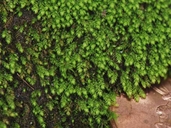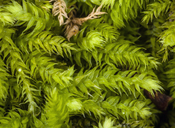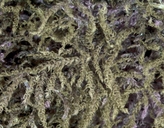- Map Distribution
- Description
- eFlora Distribution
- Illustrations
- Cal Photos images
- Elevation by latitude plot
MAP CONTROLS
1. You can change the display of the base map and layers by clicking on the layer control box in the upper right-hand corner.
2. California county polygons can be turned off and on in the layer control box.
3. Filling of Jepson subdivision polygons can be turned off and on in the layer control box.
Database links
UC Specimens in the University and Jepson Herbaria Public Portal
Specimens of Claopodium whippleanum in the Consortium of North American Bryophyte Herbaria portal (CNABH)
Claopodium whippleanum
Plants to 4 cm long in intricate, sparingly branched deep green to yellow green mats. Stems and branches little differentiated. Leaves to 1 mm long, 4–5: 1, ovate-lanceolate, gradually tapering at about 2/3 to the narrow acumen. Leaves somewhat concave, erect and overlapping with the apices rigidly erect, not catenulate, little distorted when dry. Margins plane, decurrent by 1–2 smooth and elongate cells, serrate throughout, with the teeth often somewhat recurved in the plane of the leaf. Median cells often very irregular in size and shape, mostly elliptic to rhomboidal with the walls evenly thickened throughout, 4–6 µm wide, 1.5–4: 1, high unipapillose on both surface with the papillar salients up to 4 µm high and covering most of the lumen. Juxtacostal cells, especially the basal, longer and with lower papillae. Marginal cells in one to several rows abruptly longer than adjacent laminal cells, typically smooth. Apical cell typically very short, often isodiametric. Alar cells not differentiated. Costa ending in acumen within a few cells of leaf apex, mostly prorate spinose dorsally in its distal portions. Axillary hairs not offset from leaf insertion, to 60 µm long, 3 celled, with one poorly differentiated basal brown cell. Pseudoparaphyllia arched over bud, broadly triangular to orbicular, very coarsely serrate, high papillose.
Dioicous with male plants somewhat smaller than the females. Perichaetia on main stems with bracts very pale to bleached green, somewhat longer than vegetative leaves. Seta brown to deep red brown, papillose, to 1 cm long. Urn red brown, strongly inclined to nearly pendent, oblong and asymmetric, to 2: 1, to 1.5 mm long, strangulate when dry. Operculum rostrate, about 1/2 as long as urn. Exothecial cells short rectangular, 1.5–3.0: 1, to 25 µm wide, rather thick walled with strong corner thickenings, Annulus well differentiated, not revoluble. Exostome to 400 µm long, red-brown, horizontally striate at base, nearly smooth distally. Endostome almost as long as exostome, with basal membrane comprising about 1/2. Endostome processes lightly papillose, keeled and perforate, with 2–3 cilia. Spores smooth, to 14 µm in diameter.
The genus Claopodium in California can usually be recognised by the costate and catenulate, papillose leaves. Two of our species are primarily epilithic and epiphytic, and they are automatically recognised by the very long and somewhat hyaline leaf apex formed of much elongated cells. C. whippleanum grows primarily on soil of trail banks and moderately dry forest floor, especially near the coast. It is easy to recognise in the field because of the golden green cast of the quite small plants. It is found primarily at lower to middle elevations, especially in conifer forests. It is endemic to the west coast of North America except for a single puzzling occurrence in Portugal.
Vouchers: Riverside Co.: Deep Springs Trail, San Jacinto State Park, San Jacinto Mountains, Harpel 554 (pers. herb.); San Bernardino Co.: Kingston Peak, Kingston Wilderness, Mojave Desert, Laeger & Bogan 1765 (CAS); San Francisco Co.: Mt. Davidson, Shevock 19297; Santa Barbara Co.: Windmill Canyon, Santa Rosa Island, Channel Islands National Park, Shevock 20904; Siskiyou Co.: Soda Creek about 4 miles northeast of Interstate 5 near Dunsmuir, Shasta-Trinity National Forest, Norris 84804; Sonoma Co.: Hamilton Ranch, 1 mile from Old Adobe east of Petaluma, Koch 337 (UC): Tulare Co.: General's Highway, 2.1 miles above Potwisha Campground and 0.2 miles below Hospital Rock, Middle Fork Kaweah River, Sequoia National Park, Shevock 15180.
Literature: Best 1897; Bourell 1981; Harpel 1980a; Harthill et al. 1979; Holmberg 1969; Jamieson 1969; Kellman 2003; Koch 1950a, 1951e; Koch and Ikenberry 1954; Lawton 1971; Lesquereux 1868; Long 1978; McCleary 1972; Mishler 1978; Noguchi 1964; Sayre 1940; Shevock and Toren 2001; Showers 1982; Sigal 1975; Smith 1970; Steere 1954; Steere et al. 1954; Thomson and Ketchledge 1958; Toren 1977; Whittemore and Sommers 1999; Yurky 1990, 1995. As Claopodium leuconeuron Bradshaw 1926; Howe 1896; Kingman 1912; Millspaugh and Nuttall 1923. As Claopodium whippleanum var. leuconeuron McCleary 1972. As Hypnum whippleanum Sullivant 1856; Watson 1880.
Geographic subdivisions for Claopodium whippleanum: CaR, CW, DMoj, NW, SN, SW. |
Illustration References: Malcolm et al. 2009 p. 250; Lawton 1971; Noguchi 1964; Sharp et al. 1994.









